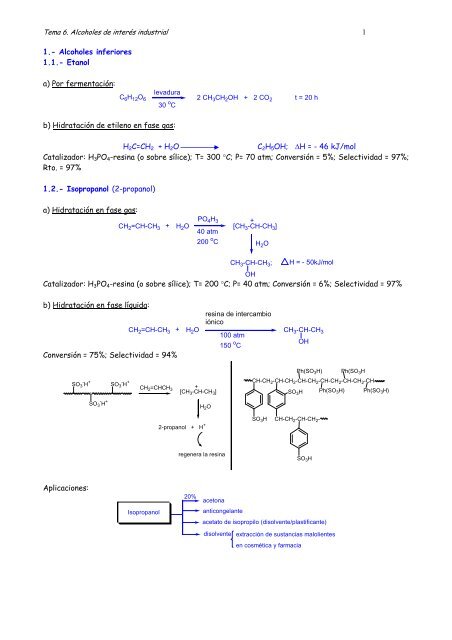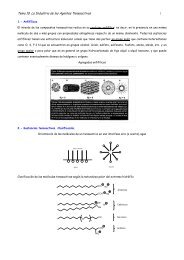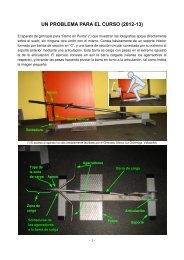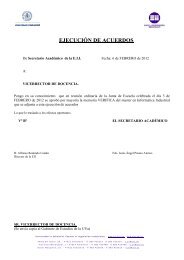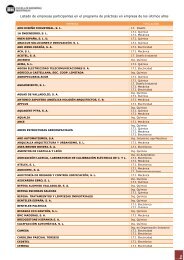1 1.- Alcoholes inferiores 1.1.- Etanol a) Por fermentación: b ...
1 1.- Alcoholes inferiores 1.1.- Etanol a) Por fermentación: b ...
1 1.- Alcoholes inferiores 1.1.- Etanol a) Por fermentación: b ...
You also want an ePaper? Increase the reach of your titles
YUMPU automatically turns print PDFs into web optimized ePapers that Google loves.
Tema 6. <strong>Alcoholes</strong> de interés industrial 1<br />
<strong>1.</strong>- <strong>Alcoholes</strong> <strong>inferiores</strong><br />
<strong>1.</strong><strong>1.</strong>- <strong>Etanol</strong><br />
a) <strong>Por</strong> <strong>fermentación</strong>:<br />
C 6H 12O 6<br />
levadura<br />
30 o C<br />
b) Hidratación de etileno en fase gas:<br />
2 CH 3CH 2OH + 2 CO 2<br />
t = 20 h<br />
H2C=CH2 + H2O C2H5OH; ΔH = - 46 kJ/mol<br />
Catalizador: H3PO4-resina (o sobre sílice); T= 300 °C; P= 70 atm; Conversión = 5%; Selectividad = 97%;<br />
Rto. = 97%<br />
<strong>1.</strong>2.- Isopropanol (2-propanol)<br />
a) Hidratación en fase gas:<br />
CH 2=CH-CH 3 + H 2O<br />
PO4H3 40 atm<br />
200 o C<br />
+<br />
[CH3-CH-CH3] CH3-CH-CH3; H = - 50kJ/mol<br />
OH<br />
Catalizador: H3PO4-resina (o sobre sílice); T= 200 °C; P= 40 atm; Conversión = 6%; Selectividad = 97%<br />
b) Hidratación en fase líquida:<br />
CH 2=CH-CH 3 + H 2O<br />
Conversión = 75%; Selectividad = 94%<br />
SO 3 - H +<br />
Aplicaciones:<br />
SO 3 - H +<br />
SO 3 - H +<br />
CH 2=CHCH 3<br />
Isopropanol<br />
+<br />
[CH3-CH-CH3] 100 atm<br />
150 o C<br />
H 2O<br />
resina de intercambio<br />
iónico<br />
H 2O<br />
2-propanol + H +<br />
regenera la resina<br />
20%<br />
CH3-CH-CH3 OH<br />
Ph(SO3H) Ph(SO3H CH-CH2-CH-CH2-CH-CH2-CH-CH2-CH-CH2-CH- SO3H Ph(SO3H) Ph(SO3H) SO 3H<br />
CH-CH 2-CH-CH 2-<br />
SO 3H<br />
acetona<br />
anticongelante<br />
acetato de isopropilo (disolvente/plastificante)<br />
disolvente extracción de sustancias malolientes<br />
en cosmética y farmacia
Tema 6. <strong>Alcoholes</strong> de interés industrial 2<br />
<strong>1.</strong>3.- Butanoles<br />
a) Butanol/Isobutanol: Procedimientos industriales de preparación.<br />
<strong>1.</strong> OH<br />
CH3-CH=CH2 + CO + H2 <strong>1.</strong> HIDROFORMILACION<br />
CH3CH2CH2CH2OH CH3CHCH2OH CH3 CON. ALDÓLICA<br />
2 CH3CHO - /calor<br />
H2 (cat.:comp. de Co)<br />
2. HIDROGENACIÓN<br />
(H2 / Ni)<br />
2. H2/Ni CH3CH2OH Ag<br />
FERMENTACION<br />
HIDRATOS DE CARBONO<br />
(Brasil)<br />
b) 2-Butanol/2-Metil-2-propanol<br />
FERMENTACION<br />
ALMIDON<br />
(U. Sovietica)<br />
1 Tm: 240 Kg butanol<br />
120 Kg acetona<br />
50 Kg etanol<br />
450 Kg CO 2 y H 2O<br />
H2C CH2 + 1/2 O2 Fabricación de butanol por <strong>fermentación</strong> de almidón<br />
CH 3-CH=CH-CH 3<br />
CH 3CH 2-CH=CH 2<br />
CH 3-C=CH 2<br />
CH 3<br />
resinas i.o.<br />
H 2O<br />
resinas i.o.<br />
H 2O<br />
CH3-CH2-CH-CH3 OH<br />
OH<br />
CH3-C-CH3 CH3 PdCl 2/CuCl 2
Tema 6. <strong>Alcoholes</strong> de interés industrial 3<br />
2.- <strong>Alcoholes</strong> amílicos (o pentanoles)<br />
3.- <strong>Alcoholes</strong> superiores<br />
3.<strong>1.</strong> <strong>Alcoholes</strong> plastificantes<br />
A) Hidroformilación de olefinas<br />
B) Condensación aldólica<br />
3.2. <strong>Alcoholes</strong> detergentes<br />
CH 3CH 2CH=CH 2 + CH 3CH=CHCH 3<br />
Co(CO) 3<br />
CO/H 2<br />
CH 3(CH 2) 3CHO + CH 3CHCH 2CH 3<br />
H 2<br />
CHO<br />
CH 3(CH 2) 3CH 2OH + CH 3CHCH 2CH 3<br />
CH 2OH<br />
1-pentanol 2-metil-1-butanol<br />
CH2=CH-(CH2) 4-CH3 + CO + H2<br />
H 3C<br />
Co(CO) 3<br />
C CH 2<br />
CH 3<br />
CO/H 2<br />
CH 3-CH-CH 2-CHO<br />
CH 3<br />
H 2<br />
CH 3-CH-CH 2-CH 2OH<br />
CH 3<br />
alcohol isoamílico<br />
HOH2C-CH2-CH2-(CH2) 4-CH3 HOH2C-CH-(CH2) 4-CH3 CH 3<br />
2 CH3CH2CH2CHO CH3-CH2-CH2-CH2-CH-CH2OH CH2CH3 A) Hidrogenación catalítica de los ácidos grasos<br />
CH 2-O-CO-R 1<br />
CH-O-COR2 CH2-O-COR1 H 2O o MeOH<br />
ZnO<br />
H 2(g) en exceso/200 o C-250 atm<br />
oxidos de Cr/Cu<br />
B) Oxidación parcial de n-parafinas a alcoholes<br />
CH 2-OH<br />
CH-OH<br />
CH2-OH + R1COOR + R2-COOR; (R=H o Me)<br />
H2; cat. 250 atm; 300 o C<br />
2 R 1CH 2OH + R 2-CH 2OH + H 2O<br />
R 1 -CH2-CH2-R 2 + 0,5 O2 R 1 -CH(OH)-CH2-R 2 + R 1 -CH2-CH(OH)-R 2<br />
C) Obtención de alcoholes por el proceso Alfol<br />
Al(finamente dividido) + 3 H2C=CH2 + 3 H2 Al(CH2CH3)3<br />
Al(CH2CH3)3 + 3n H2C=CH2 Al[(CH2CH2)n-CH2CH3]3; n = 10-14<br />
Al[(CH2CH2)n-CH2CH3]3 + 1,5 O2 Al[O(CH2CH2)n-CH2CH3]3<br />
3 CH3(CH2CH2)n-CH2OH + Al(OH)3 (n=10-14)


